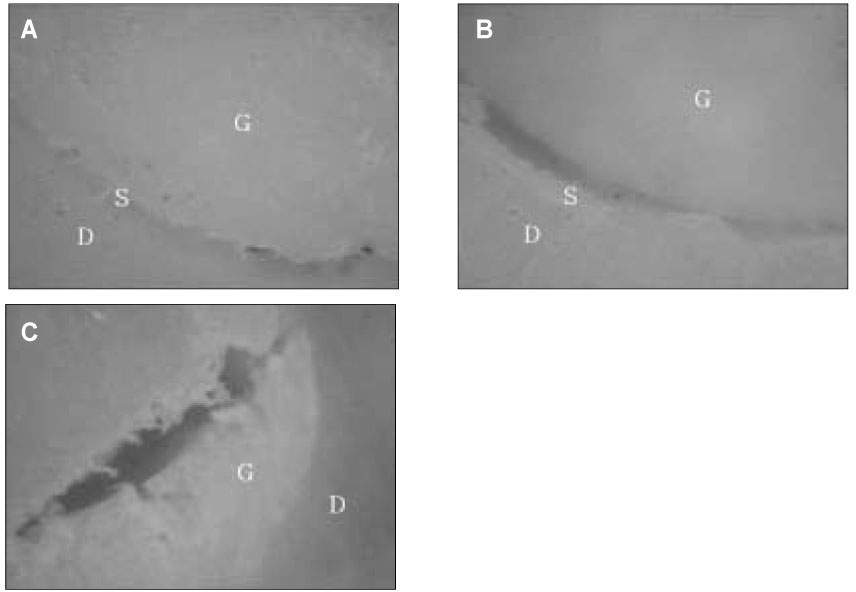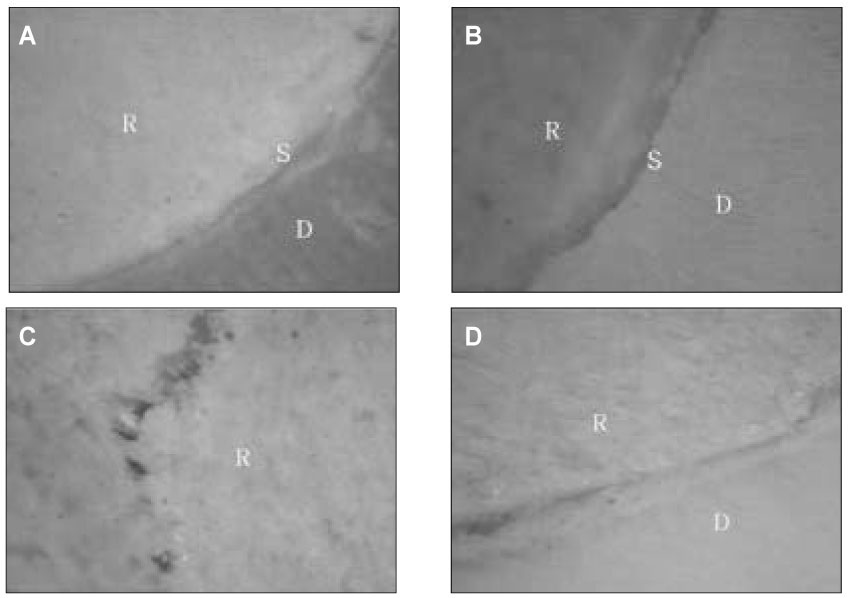Articles
- Page Path
- HOME > Restor Dent Endod > Volume 33(2); 2008 > Article
- Original Article Effect of irrigation methods on the adhesion of Resilon/Epiphany sealer and gutta-percha/AH 26 sealer to intracanal dentin
- Seo-Kyong Kim, Yun-Chan Hwang, In-Nam Hwang, Won-Mann Oh
-
2008;33(2):-106.
DOI: https://doi.org/10.5395/JKACD.2008.33.2.098
Published online: March 31, 2008
Department of Conservative Dentistry, School of Dentistry, DSRI, Chonnam National University, BK21, Korea.
- Corresponding Author: Won-Mann Oh. Department of Conservative Dentistry, School of Dentistry, Chonnam National University, 8 Hak-dong, Dong-gu, Gwangju 501-757, Korea. Tel: 82-62-220-4431, Fax: 82-62-225-8387, wmoh@chonnam.ac.kr
Copyright © 2008 Korean Academy of Conservative Dentistry
- 673 Views
- 4 Download
Abstract
-
The purpose of this study was to evaluate whether intracanal irrigation method could affect the adhesion between intracanal dentin and root canal filling materials (Gutta-percha/AH 26 sealer and Resilon/Epiphany sealer).Thirty extracted human incisor teeth were prepared. Canals were irrigated with three different irrigation methods as a final rinse and obturated with two different canal filling materials (G groups : Gutta-percha/AH 26 sealer, R groups : Resilon/Epiphany sealer) respectively.Thirty obturated roots were horizontally sliced and push-out bond strength test was performed in the universal testing machine. After test, the failure patterns of the specimens were observed using Image-analyzing microscope.The results were as follows.
Gutta-percha/AH 26 sealer groups had significantly higher push-out bond strength compared with the Resilon/Epiphany sealer groups (p < 0.05).
Push-out bond strength was higher when using 17% EDTA followed by sterile saline than using NaOCl as a final irrigation solution in the Resilon/Epiphany sealer groups (p < 0.05).
In the failure pattern analysis, there was no cohesive failure in Group G1, G2, and R1. Gutta-percha/AH 26 sealer groups appeared to exhibit predominantly adhesive and mixed failure patterns, whereas Resilon/Epiphany sealer groups exhibited mixed failures with the cohesive failure occurred within the Resilon substrate.
- 1. Grossman LI, Oliet S, Del Rio CE. Endodontic Practice. 11th edn. Philadelphia: Lea & Febiger; 255.
- 2. Tagger M, Tagger E, Tjan AH, Bakland LK. Measurement of adhesion of endodontic sealers to dentin. J Endod. 2002;28: 351-354.ArticlePubMed
- 3. Ørstavik D, Eriksen HM, Beyer-olsen EM. Adhesive properties and leakage of root canal sealers in vitro. Int Endod J. 1983;16: 59-63.ArticlePubMed
- 4. Torabinejad M, Ung B, Kettering JD. In vitro bacterial penetration of coronally unsealed endodontically treated teeth. J Endod. 1990;16: 566-569.ArticlePubMed
- 5. Shipper G, Ørstavik D, Teixeira FB, Trope M. An evaluation of microbial leakage in roots filled with a thermoplastic synthetic polymer-based root canal filling material (Resilon). J Endod. 2004;30: 342-347.ArticlePubMed
- 6. Tay FR, Loushine RJ, Weller RN, Kimbrough WF, Pashley DH, Mak YF, Lai CS, Raina R, Williams MC. Ultrastructural evaluation of the apical seal in roots filled with a polycaprolactone-based root canal filling material. J Endod. 2005;31: 514-519.ArticlePubMed
- 7. Teixeira FB, Teixeira EC, Thompson JY, Trope M. Fracture Resistance of endodontically treated roots using a new type of resin filling material. J Am Dent Assoc. 2004;135: 646-652.PubMed
- 8. Sly MM, Moore BK, Platt JA, Brown CE. Push-out Bond Strength of a New Endodontic Obturation System (Resilon/Epiphany). J Endod. 2007;33: 160-162.ArticlePubMed
- 9. Johnson WT, Gutmann JL. In: Cohen S, Hagreaves KM, editors. Obturation of the cleaned and shaped root canal system. Pathways of the pulp. 2006;7th ed. St Louis: Mosby; 368-369.Article
- 10. Branstetter J, von Fraunhofer JA. The physical properties and sealing action of endodontic sealer cements : a review. J Endod. 1982;8: 312-316.PubMed
- 11. Zmener O, Spielberg C, Lamberghini F, Rucci M. Sealing properties of a new epoxy resin-based root-canal sealer. Int Endod J. 1997;30: 332-334.ArticlePubMed
- 12. Wennber A, Ørstavik D. Adhesion of root canal sealers to bovine dentine and gutta-percha. Int Endod J. 1990;23: 13-19.ArticlePubMed
- 13. Teixeira FB, Teixeira EC, Thompson JY, Trope M. Fracture resistance of roots endodontically treated with a new resin filling material. J Am Dent Assoc. 2004;135: 646-652.ArticlePubMed
- 14. Gesi A, Raffaelli O, Goracci C, Pashley DH, Tay FR, Ferrari M. Interfacial strength of Resilon and guttapercha to intraradicular dentin. J Endod. 2005;31: 809-813.ArticlePubMed
- 15. Tay FR, Pashley DH, Williams MC, Raina R, Loushine RJ, Weller RN, Kimbrough WF, King NM. Susceptibility of a polycaprolactone-based root canal filling material to degradation. I. Alkaline hydrolysis. J Endod. 2005;31: 593-598.ArticlePubMed
- 16. Nikaido T, Takano Y, Sasafuchi Y, Burrow MF, Tagami J. Bond strengths to endodontically-treated teeth. Am J Dent. 1999;12: 177-180.PubMed
- 17. Ungor M, Onay EO, Orucoglu H. Push-out bond strengths: the Epiphany-Resilon endodontic obturation system compared with different pairings of Epiphany, Resilon, AH Plus and gutta-percha. Int Endod J. 2006;39: 643-647.PubMed
- 18. Sagsen B, Er O, Kahraman Y, Akdogan G. Resistance to fracture of roots filled with three different techniques. Int Endod J. 2007;40: 31-35.ArticlePubMed
- 19. Burtscher P. Stability of radicals in cured composite materials. Dent Mater. 1993;9: 218-221.ArticlePubMed
- 20. Skidmore LJ, Berzins DW, Bahcall JK. An in vitro comparison of the intraradicular dentin bond strength of Resilon and gutta-percha. J Endod. 2006;32: 963-966.ArticlePubMed
- 21. Bouillaguet S, Troesch S, Wataha JC, Krejci I, Meyer JM, Pashley DH. Microtensile bond strength between adhesive cements and root canal dentin. Dent Mater. 2003;19: 199-205.ArticlePubMed
- 22. Ferracane JL. Developing a more complete understanding of stresses produced in dental composites during polymerization. Dent Mater. 2005;21: 36-42.ArticlePubMed
- 23. Alster D, Feilzer AJ, de Gee AJ, Davidson CL. Polymerization contraction stress in thin resin composite layers as a function of layer thickness. Dent Mater. 1997;13: 146-150.ArticlePubMed
- 24. Goldman M, Goldman LB, Cavaleri R, Bogis J, Lin PS. The efficacy of several endodontic irrigating solutions : a scanning electron microscopic study. part 2. J Endod. 1982;8: 487-492.ArticlePubMed
- 25. Baumgartner JC, Mader CL. A scanning electron microscopic evaluation of four root canal irrigation regimens. J Endod. 1987;13: 147-157.ArticlePubMed
REFERENCES




Tables & Figures
REFERENCES
Citations






Figure 1
Figure 2
Figure 3
Figure 4
Figure 5
Group classification
Push-out bond strength for each group (Mean ± S.D. (MPa))
Failure pattern analysis

 KACD
KACD




 ePub Link
ePub Link Cite
Cite

